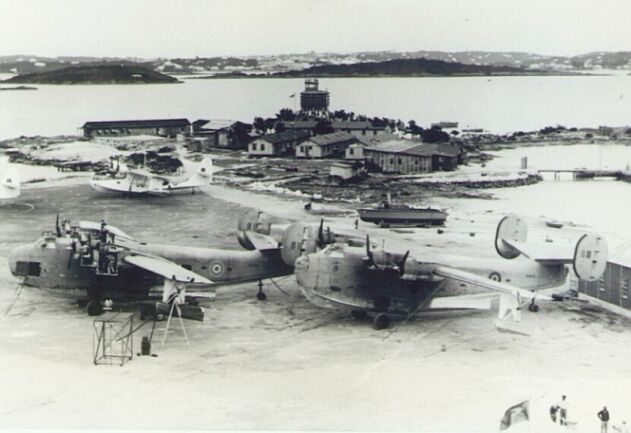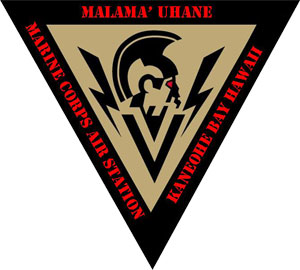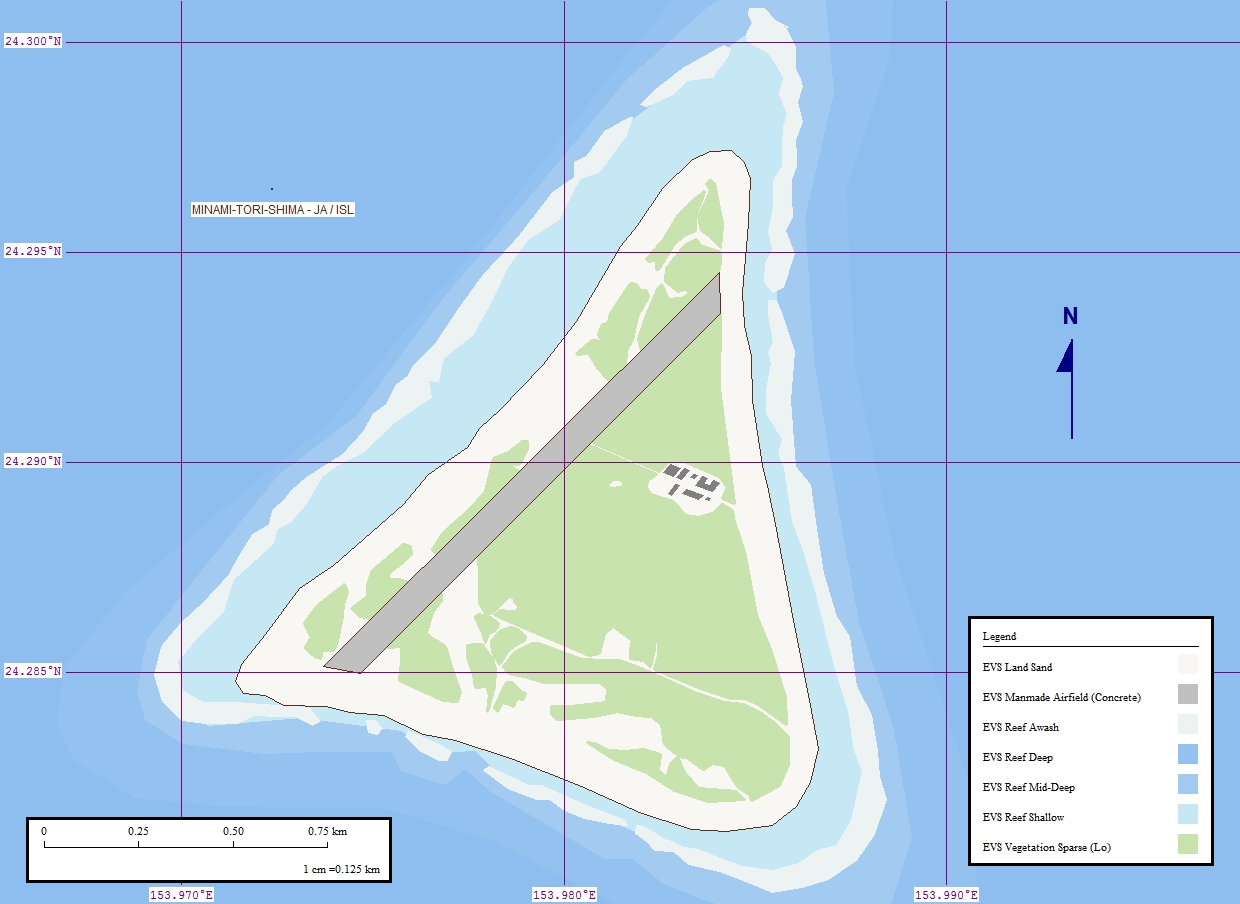|
VPB-15
VPB-15 was a Patrol Bombing Squadron of the U.S. Navy. The squadron was established as Patrol Squadron 15 (VP-15) on 15 March 1943, redesignated Patrol Bombing Squadron 15 (VPB-15) on 1 October 1944 and disestablished on 23 November 1945. Operational history *15 March 1943: VP-15 was established at NAS San Diego, California, under the operational control of FAW-14. The squadron was equipped with the PB2Y-3 Coronado heavy seaplane. *15 May 1943: Upon completion of the squadron shakedown of personnel and equipment, VP-15 was transferred to NAS Bermuda under the operational control of FAW-5. Principal duties were to provide ASW, patrol searches and convoy coverage along the eastern seaboard. On 1 August 1943, administrative control shifted from FAW-5 to FAW-9. *21 April 1944: VP-15 was transferred to NAS Coco Solo, Panama Canal Zone, under the operational control of FAW-3. One detachment was deployed to Corinto, Nicaragua, and a second to the Galapagos Islands. *15 October 1944: V ... [...More Info...] [...Related Items...] OR: [Wikipedia] [Google] [Baidu] |
List Of Inactive United States Navy Aircraft Squadrons
There are hundreds of US Navy aircraft squadrons which are not currently active dating back to before World War II (the U.S. Navy operated aircraft prior to World War I, but it did not organize them in squadrons until after that war). To be more accurate: there are hundreds of former U.S. Navy aircraft squadrons which have been disestablished and no longer exist and there are approximately 40 or so U.S. Navy aircraft squadrons which have been deactivated and which currently exist only "on paper" in an inactive status. These disestablished and/or deactivated squadrons are sometimes incorrectly referred to as "decommissioned" squadrons, but proper usage prior to 1998, was that squadrons were "established" and "disestablished" and after 1998, squadrons are "established", "deactivated" and sometimes "reactivated". It has never been correct to refer to U.S. Navy aircraft squadrons as being "commissioned" and "decommissioned", ships are commissioned and decommissioned, U.S. Navy aircr ... [...More Info...] [...Related Items...] OR: [Wikipedia] [Google] [Baidu] |
List Of Squadrons In The Dictionary Of American Naval Aviation Squadrons
The tables below cover every one of the 280 squadrons listed in the U.S. Navy's two-volume ''Dictionary of American Naval Aviation Squadrons'' (''DANAS''). Volume 1 covers every squadron in the Attack (VA) and Strike Fighter (VFA) communities from 1935 to 1995. Volume 2 covers every squadron in the Patrol (VP) community from 1922 through 1996. You can see any squadron's ''DANAS'' article by following the link to the cited reference and scrolling down to the appropriate page. You can see its Wikipedia article by clicking the Wikilink in the table; if there is no Wikilink, there is no known article for the squadron. VA squadrons This table shows the 88 VA Attack Squadrons listed iVolume 1of ''DANAS''. A detailed lineage list for all squadrons mentioned in Volume 1 is availabl The articles for these squadrons are in the process of being renamed to parallel the names of articles in the other sections. For example, ''Third VA-34 (U.S. Navy)'' will become merely ''VA-34''. This is an ... [...More Info...] [...Related Items...] OR: [Wikipedia] [Google] [Baidu] |
Consolidated PB2Y Coronado
The PB2Y Coronado is a large flying boat patrol bomber designed by Consolidated Aircraft, and used by the US Navy during World War II in bombing, antisubmarine, and transport roles. Obsolete by the end of the war, Coronados were quickly taken out of service. Only one known example remains, at the National Naval Aviation Museum at Naval Air Station Pensacola, Florida. Design and development After deliveries of the PBY Catalina, also a Consolidated aircraft, began in 1935, the United States Navy began planning for the next generation of patrol bombers. Orders for two prototypes, the XPB2Y-1 and the Sikorsky XPBS-1, were placed in 1936; the prototype Coronado first flew in December 1937. After trials with the XPB2Y-1 prototype revealed some stability issues, the design was finalized as the PB2Y-2, with a large cantilever wing, twin tail with very marked dihedral, and four Pratt & Whitney R-1830 radial engines. The two inner engines were fitted with four-bladed reversible pitc ... [...More Info...] [...Related Items...] OR: [Wikipedia] [Google] [Baidu] |
NAS Kaneohe Bay
Marine Corps Air Station Kaneohe Bay or MCAS Kaneohe Bay is a United States Marine Corps (USMC) airfield located within the Marine Corps Base Hawaii complex, formerly known as Marine Corps Air Facility (MCAF) Kaneohe Bay or Naval Air Station (NAS) Kaneohe Bay. Most of the original contract work at Kaneohe had been completed when the Navy transferred what was undone to the Seabees of the 56th Naval Construction Battalion on 1 April 1943. The 112th CB was tasked with adding a second runway 400' x 5,000' to the airfield. That was completed by the men of the 74th CB. December 7, 1941, the Imperial Japanese Navy attacked the air station minutes prior to the attack on Pearl Harbor. Of the 36 Catalinas stationed here, 27 were destroyed and six others were damaged, along with 18 sailors who perished in the attack. The first Japanese aircraft destroyed in action were shot down at Kaneohe, along with Aviation Ordnanceman Chief Petty Officer John William Finn becoming one of the first Med ... [...More Info...] [...Related Items...] OR: [Wikipedia] [Google] [Baidu] |
History Of The United States Navy
The history of the United States Navy divides into two major periods: the "Old Navy", a small but respected force of sailing ships that was notable for innovation in the use of ironclads during the American Civil War, and the "New Navy" the result of a modernization effort that began in the 1880s and made it the largest in the world by 1943. The United States Navy claims October 13, 1775 as the date of its official establishment, when the Second Continental Congress passed a resolution creating the Continental Navy. With the end of the American Revolutionary War, the Continental Navy was disbanded. Under the Presidency of John Adams, merchant shipping came under threat while in the Mediterranean by Barbary pirates from four North African States. This led to the Naval Act of 1794, which created a permanent standing U.S. Navy. The original six frigates were authorized as part of the Act. Over the next 20 years, the Navy fought the French Republic Navy in the Quasi-War (1 ... [...More Info...] [...Related Items...] OR: [Wikipedia] [Google] [Baidu] |
List Of United States Navy Aircraft Squadrons
This is a list of active United States Navy aircraft squadrons. ''Deactivated'' or ''disestablished'' squadrons are listed in the List of inactive United States Navy aircraft squadrons. Navy aircraft squadrons are composed of several aircraft (from as few as about four to as many as about a dozen), the officers who fly them, the officers and sailors who maintain them and administrative support officers and sailors. Some of the units listed in this article are not technically "squadrons", but they all operate U.S. Navy aircraft in some capacity. Squadrons and their history are listed in the '' Dictionary of American Naval Aviation Squadrons'' (DANAS). Squadron organization Active duty squadrons are typically Time commanded by a commander. Second in command is the executive officer (XO), also a commander. The XO typically assumes command of the squadron after approximately 15 months. There are typically four functional departments – Operations, Maintenance, Safety/NATOPS, and A ... [...More Info...] [...Related Items...] OR: [Wikipedia] [Google] [Baidu] |
Maritime Patrol Aircraft
A maritime patrol aircraft (MPA), also known as a patrol aircraft, maritime reconnaissance aircraft, or by the older American term patrol bomber, is a fixed-wing aircraft designed to operate for long durations over water in maritime patrol roles — in particular anti-submarine warfare (ASW), anti-ship warfare (AShW), and search and rescue (SAR). Among other maritime surveillance resources, such as satellites, ships, unmanned aerial vehicles (UAVs) and helicopters, the MPA is an important asset. To perform ASW operations, MPAs typically carry air-deployable sonar buoys as well as torpedoes and are usually capable of extended flight at low altitudes. History First World War The first aircraft that would now be identified as maritime patrol aircraft were flown by the Royal Naval Air Service and the French Aéronautique Maritime during the First World War, primarily on anti-submarine patrols. France, Italy and Austria-Hungary used large numbers of smaller patrol aircraft ... [...More Info...] [...Related Items...] OR: [Wikipedia] [Google] [Baidu] |
NAB Saipan
Naval Base Saipan or Naval Advance Base Saipan or Naval Air Base Saipan was a United States Navy Naval base built during World War II to support Pacific Ocean theater of war and the many warships and troops fighting the war. The base was on the island of Saipan in the Northern Mariana Islands. The base was part of the Pacific island hopping campaign. The base construction started after the Battle of Saipan ended on July 9, 1944. US Naval Advance Base Saipan was constructed by the Seabees Naval Mobile Construction Battalions. The base was under the Commander Naval Forces Marianas. Saipan is long and wide. About 70% of the island was sugarcane cultivation at the start of the base construction. At the start of the Battle of Saipan, the island's population had about 30,000 Japanese troops and about 20,000 Japanese civilians. The city of Garapan was the administrative center for the Saipan governmental district. The Navy used 110 ships to bring troops and equipment to Saipan from ... [...More Info...] [...Related Items...] OR: [Wikipedia] [Google] [Baidu] |
Marcus Island
, also known as Marcus Island, is an isolated Japanese coral atoll in the northwestern Pacific Ocean, located some southeast of Tokyo and east of the closest Japanese island, South Iwo Jima of the Ogasawara Islands, and nearly on a straight line between mainland Tokyo and Wake Island, further to the east-southeast. The closest island to Minamitorishima is East Island in the Mariana Islands, which is to the west-southwest. It is the easternmost territory belonging to Japan, and the only Japanese territory on the Pacific Plate, past the Japan Trench. Although small () it is of strategic importance, as it enables Japan to claim a exclusive economic zone in the surrounding waters. It is also the easternmost territory of Tokyo, being administratively part of Ogasawara village. There is no civilian population, except personnel of the Japan Meteorological Agency, JSDF, and Japan Coast Guard serving temporary tours of duty on the island. Access The island is off-limits t ... [...More Info...] [...Related Items...] OR: [Wikipedia] [Google] [Baidu] |
Kerama Islands
The are a subtropical island group southwest of Okinawa Island in Japan. Geography Four islands are inhabited: Tokashiki Island, Zamami Island, Aka Island, and Geruma Island. The islands are administered as Tokashiki Village and Zamami Village within Shimajiri District. The Kerama-shotō coral reef is a Ramsar Site. The archipelago consists of the following islands (-jima/-shima) - inhabited ones are highlighted in blue - and rocks (other suffixes, unnamed entries) with an area of at least 0.01 km². Flora The archipelago has several extensive coral reefs. Two of them were designated as Ramsar sites in November 2005: a 120-hectare area along the west coast of Tokashiki-jima and around Hanari-jima, and a 233-hectare area around Ijakaja-jima, Gahi-jima and Agenashiku-jima , i.e. H. between Aka Island and Zamami Island. These reefs are home to 248 different coral species, most notably of the Acropora genus. On March 5, 2014, the waters and the islands were placed unde ... [...More Info...] [...Related Items...] OR: [Wikipedia] [Google] [Baidu] |
Tanapag Harbor
Tanapag Harbor () is the primary harbor of Saipan, and is located on the western side of the island in the city of Tanapag. It is separated from the Philippine Sea by a barrier reef, located about 3 km (2 miles) off the shore. This reef forms the Saipan Lagoon. During World War II the harbor was occupied and used by Japan and later the United States as Naval Advance Base Saipan with the code name Dugout Zero. Following the war the harbor facilities have been significantly expanded to provide support for the United States Navy The United States Navy (USN) is the maritime service branch of the United States Armed Forces and one of the eight uniformed services of the United States. It is the largest and most powerful navy in the world, with the estimated tonnage .... at GlobalSecurity.org This port is also called Puetton T ... [...More Info...] [...Related Items...] OR: [Wikipedia] [Google] [Baidu] |
Seymour Airport
Seymour Galapagos Ecological Airport (Spanish: ''Aeropuerto Ecológico Galápagos Seymour'') is an airport serving the island of Baltra, one of the Galápagos Islands in Ecuador. Facilities The airport became the world's first "green" airport in December 2012. The new terminal, which consists of recycled steel tubes taken from oil drilling operations in the Amazon, is spread over 6,000 square meters and required an investment of just over $24 million. The new complex will use clean, renewable technologies such as solar energy, wind farms, and seawater desalination, among other environmental innovations. According to ECOGAL, the company that operates the terminal, construction of the new airport took into account the surrounding environment and sought to make a minimal impact on the ecosystem. The project was announced in 2008, with construction commencing in 2012. The purpose of the redevelopment from the outset was to create the world's first ecological airport. ECOGAL w ... [...More Info...] [...Related Items...] OR: [Wikipedia] [Google] [Baidu] |




.jpg)



.jpg)